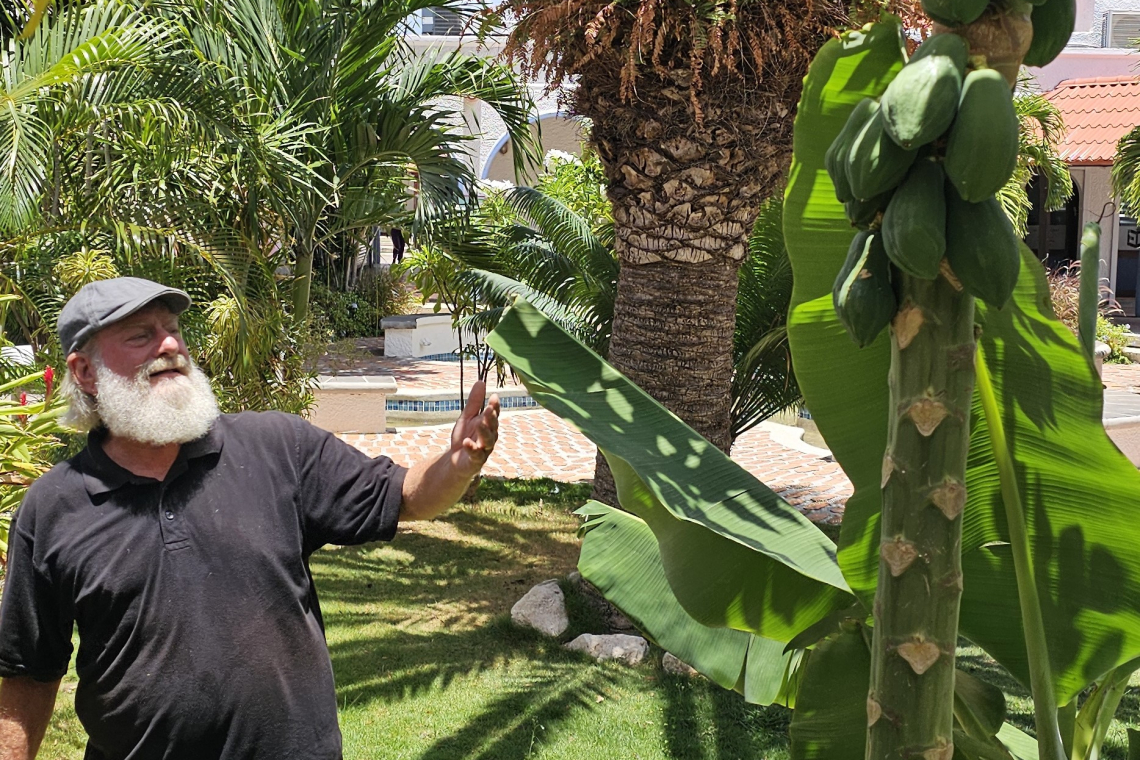By Rajesh Chintaman
On an island where everything feels urgent with development, deadlines and decisions, the quiet lives of trees and plants rarely become the topic of discussion. Yet sitting across from Dr. Jay Haviser inside the warm bustle of Top Carrot, I am reminded that St. Maarten’s future may depend not on what we build next, but on what we continue to cut down.
Archaeologist and founder of St. Maarten Archaeological Center SIMARC, Haviser doesn’t preach. He doesn’t need to. His stories – layered with decades of archaeology, anthropology, and activism – pull you in like the shade of a silk cotton tree on a scorching afternoon.
The first thing he tells me is that trees were never “extra” to this island; they were the foundation. “For the earliest people who lived here,” he begins, “trees were everything: food, shelter, canoes, tools. Nature and culture weren’t separate. They were one system.”
It is a humbling reminder. Long before the era of poured concrete and hillside excavation, trees shaped how communities ate, moved, survived, and related to each other. Even after waves of Europeans, Africans, and Asians brought new species such as mango, tamarind, breadfruit; trees continued to root themselves in our stories. They became landmarks, meeting points, secret gathering places during slavery. Lovers snuck into their shade.
Then he pauses, leans back, and says something that sticks with me long after I leave the café: “We’re losing that link. The relationship between humans and nature used to be intimate. Now, it’s superficial. And when you disconnect people from nature, you get bad decisions.”
Bad decisions, he has seen plenty. Haviser returns to one example with frustration still audible in his voice: The two massive mango trees that once stood near the Causeway roundabout – both centuries old; both towering symbols of a different era. “I begged them,” he says. “All they needed was a slight shift in the road. A couple of metres.” But, no. They, the trees, had to make space for the roadway.
He’s not exaggerating. Those trees were giants; landmarks passed by generations, living archives of the island. And yet, in the rush to finalise a multimillion-dollar infrastructure project, they became expendable. This, to him, is the pattern: Development first, heritage last.
He gives another example, this time far more covert. Near the old Radio Shack building, a landowner clandestinely “ringed” a huge tree by cutting a circle through the bark, slowly killing it from the inside. “They didn’t want to deal with it,” he says. “So, they quietly ended it.”
On St. Maarten, he explains, this happens more often than the public realises. Not only out of convenience, but because of a historical mindset passed down through generations: “I own the land, so I can do whatever I want.”
That attitude, Haviser warns, is one of the most dangerous forces against conservation. It treats trees as accessories rather than as shared patrimony. “We need to rethink ownership,” he says. “If you have a big tree on your land, you’re the custodian of heritage, not just the owner of a piece of dirt.”
But Haviser isn’t calling for protest marches or guilt trips. His primary solution is far more foundational: Education – real nature education starting in primary school.
He lays it out as two clear levels:
One; put tree and plant education into the school curriculum. Not as a side activity, not as a one-day field trip; but as a structured part of how young people grow up. Children should be able to identify native species, understand what the roots do, and know which trees belong to this island’s cultural story.
And, two, make politicians, community leaders, and developers understand that heritage trees are patrimony. And, yes, he stresses it: All heritage trees – not only the flamboyant, which, ironically, was chosen as the national tree despite being imported from Madagascar. “Politicians think we have a national tree, so we’re done,” he says. “But that’s not how patrimony works. We need to protect the big trees that grew with us, that hold our stories.”
There is one native tree Haviser speaks of with unmistakable affection – the silk cotton tree. In his words, it is a “griot tree” a storyteller; a guardian; a spiritual anchor. Its massive roots have sheltered people for generations; its cotton once filled bedding across the Caribbean; its towering presence still commands quiet respect.
“We’ve lost our tuning,” he says softly. “Trees radiate vibrations. They calm us; ground us. When you see a massive, old tree, something in you responds. You feel it. But we’ve forgotten how to listen.”
He believes reconnecting young people to this vibrational sense of nature is essential: Touching a tree; Sitting under one; Feeling its cool energy; Understanding that this is part of who we are.
At SIMARC, he practices what he preaches. For years, he has encouraged teenagers to plant trees, creating a personal bond they can return to decades later. “When that teenager is 36,” he says, “and they stand under the tree they planted, they feel the connection. They grow together.” This, he stresses, is what roots identity across generations.
But, education alone isn’t enough. Haviser highlights another entrenched obstacle – St. Maarten’s post-hurricane “chainsaw” response. He said, “After every storm, the chainsaws go crazy. Clear it fast. Cut everything. Don’t assess, just chop.”
He shakes his head. “It’s not sustainable. Many of those trees could be saved. I’ve done it myself.” He tells me about two large mother-in-law’s Tongue trees toppled by Hurricane Irma. Instead of cutting them up, he tied ropes to his truck, pulled the trees upright, braced them with boards and saved them. Both trees lived.
It’s not heroics, he insists. It’s basic knowledge – something any municipality, developer, or homeowner could do if they bothered. Toward the end of our conversation, I asked him what is truly at stake. His answer comes without hesitation. “We’re threatening our own tourism economy. We’re removing the natural beauty that people come here to see. One day, tourists will choose the islands that protected their trees.”
This is not an activist’s exaggeration; it is a sober assessment from someone who has spent a lifetime studying what makes societies resilient.
When we strip our hillsides bare, we are not only destroying biodiversity; we are dismantling the very backdrop of St. Maarten’s identity.
As our conversation winds down, I look at the notes filling my page. This is not a story about trees. It is a story about memory, belonging, responsibility, and what we want St. Maarten to look like in 50 years. And, perhaps, if we teach the next generation to recognise a silk cotton tree not as scenery but as kin, we might finally understand what our ancestors always knew: Trees don’t just grow on this island; they grow us!







